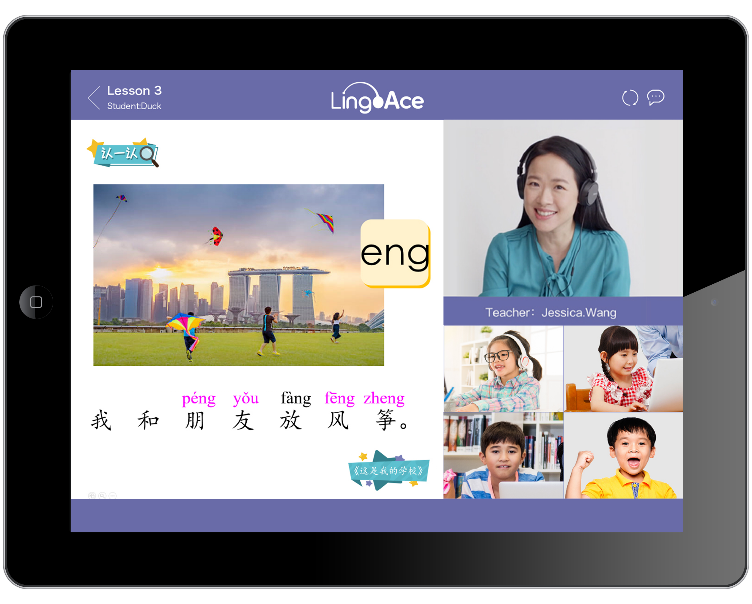Immigrant parents sometimes struggle with teaching their native language to their children. In most cases, the second generation ends up with a different first language.
Hugh Yao, founder and CEO of online language learning platform LingoAce, faced this problem after moving his family from China to Singapore in 2012. His son, who was three years old during the move, grew up with English as his first language instead of Mandarin Chinese.
“Even though most of his friends are Chinese, they talked to each other in English,” Yao told KrASIA.

He wants his son to be like him, bilingual in both Chinese and English, which will help him to secure jobs in global companies such as “Salesforce, IBM, and Oracle,” Yao expressed, adding that mastering multiple languages opens many opportunities for the future.
Since he and his wife couldn’t teach their son due to their busy schedule and lack of teaching experience, they started looking for good language learning centers. However, Yao was picky, and carefully examined each center’s curriculum and teaching method to find the best match for his son’s needs, but to no avail, he affirmed.
He realized that many parents are facing the same problem, and so he saw a business opportunity. In 2017, he launched LingoAce, fueled by a seed round from Chinese angel investment firm Decent Capital.
A personalized curriculum
LingoAce relies on similar features found on other education tech platforms to deliver lessons, such as gamification and multimedia. However, Yao said, the platform’s strength lies in its rigid academic framework.
“If we only do cartoons and games, but the academic part is missing, that would be a problem. We marry these two,” he said. The trick is to formulate a curriculum suited to a specific age group.
LingoAce targets students aged four to 15 years, divided into three age groups. For each group, there is a different teaching method. For younger students lessons are dominated by cartoon animations and interactive games supervised by teachers, while for children older than nine years old, the program becomes more academic with fewer games and cartoon content.

“Mandarin is not an easy language, the most important focus for children younger than six years old is not to teach them too much content, but how to pique their interest,” Yao said.
Another consideration is the student’s cultural background. Yao noticed that there are students who have a bilingual family, like him, and have the privilege of practicing more at home. But there are also other youngsters whose families don’t speak Chinese at all. The curriculum is tailored to suit the needs of these students, he affirmed.
The syllabus is tailored by the company’s in-house curriculum specialists, with insights from China and Singapore’s education ministry. Yao also sought an external assessment from education specialists in Chinese universities.
Each learning session, either one-on-one or in a small group of four, is recorded and assessed carefully. “We review videos from each class and analyze them using AI, for example, to monitor teacher-student interaction, student’s focus on content, or distractions. We use machine learning to assess the score. This is the end-to-end process that we’ve built,” Yao said.
Currently, the company has more than 2,000 certified teachers, all native speakers from China, teaching around 100,000 students from 80 countries. The US and Canada make up 50% of LingoAce’s users, while the rest come from Singapore, Australia, and Southeast Asian countries.
Currently, the company is employing a direct-to-customer business model, where parents pay per session. “In the future, we might partner with schools or language tuition centers,” Yao said, “But we’d like to understand more about our customers’ needs and strengthen our product offering.”
What’s next?
In November 2020, LingoAce received USD 6 million from Sequoia Capital India in an extended Series A round. The funding propelled its expansion into Indonesia and Thailand, where Yao found a growing demand for language learning due to the proliferation of Chinese businesses in the region.
“The relationship between China and Southeast Asian countries is very close in terms of trading, tourism, and education. Collaboration happens quite a lot, even investment,” he said, adding that Mandarin speaking-talents will have more work opportunities.
LingoAce is also expanding its content production team and developing new language learning tools, such as an app for practicing writing Chinese characters, while the company also wants to add more pre-recorded video lessons available on its platform to save student’s bandwidth.
Yao also plans to add lessons for other languages, with English at the top of the list. “So we can build a very strong workforce for the next 10-20 years,” he said.
This article is part of KrASIA’s “Startup Stories” series, where the writers of KrASIA speak with founders of tech companies in South and Southeast Asia.


